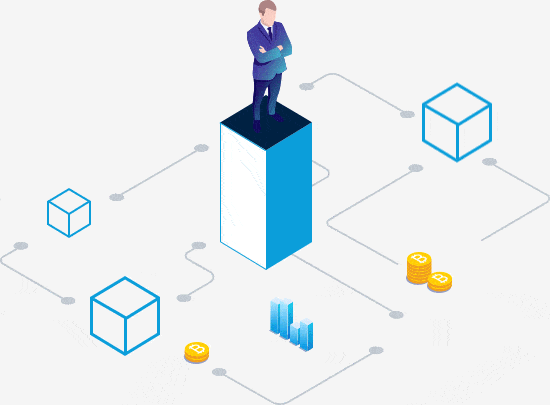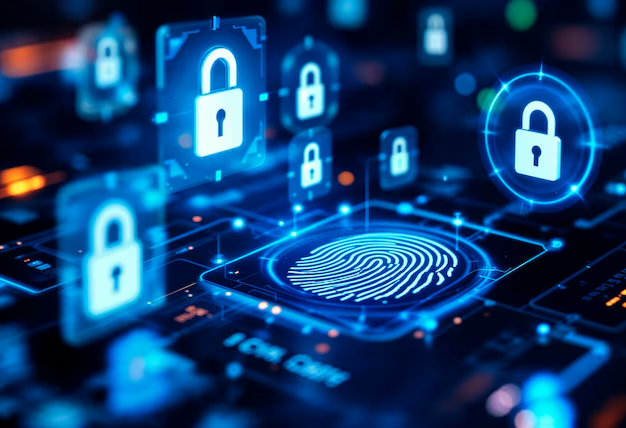Blockchain Security is more than just a buzzword; it’s a revolutionary tool transforming data security across various industries. Known primarily for its association with cryptocurrencies like Bitcoin, blockchain’s potential extends far beyond digital currency. This decentralized technology is now being leveraged to enhance data security in unprecedented ways. But what makes blockchain such a game-changer for data security? Let’s dive in.
Key Takeaways
- Decentralization Reduces Risk: Blockchain’s decentralized structure ensures that data is distributed across multiple nodes, reducing the likelihood of a single point of failure and making it significantly harder for hackers to compromise the system.
- Immutability Ensures Data Integrity: Once data is recorded on a blockchain, it cannot be altered or deleted without the consensus of the network. This makes blockchain a highly secure way to store and verify data without the risk of tampering.
- Advanced Cryptography Protects Transactions: Blockchain uses strong cryptographic techniques, such as public-key cryptography and hashing algorithms, to secure data and transactions, ensuring that only authorized users can access or alter information.
- Consensus Mechanisms Validate Transactions: Blockchain employs consensus algorithms (like Proof of Work or Proof of Stake) to ensure that only legitimate transactions are recorded, preventing fraudulent or malicious activities from entering the network.
- Smart Contracts Automate and Secure Processes: Blockchain enables self-executing smart contracts that automatically enforce predefined agreements, reducing the need for intermediaries and minimizing the risk of human error or fraud.
What is Blockchain Security?

Blockchain security refers to the set of technologies, protocols, and practices designed to protect data, transactions, and networks within a blockchain system. Since blockchain operates on a decentralized, distributed ledger where data is recorded across multiple nodes (computers), ensuring the integrity, confidentiality, and availability of this data is crucial.
Blockchain security is unique because it combines advanced cryptographic techniques, decentralization, and consensus mechanisms to secure information in a way that is nearly immune to fraud, tampering, and hacking. These features make blockchain particularly suitable for secure data storage, financial transactions, and applications where data integrity is critical.
Key Elements of Blockchain Security
- Cryptography:
- Blockchain uses public-key cryptography and hash functions to secure transactions. Public and private keys are used to encrypt and decrypt data, ensuring that only authorized users can access or modify information. Hashing algorithms ensure that data cannot be tampered with once it’s added to the blockchain.
- Decentralization:
- One of the core principles of blockchain security is its decentralized nature. Data is stored across a distributed network of nodes, meaning there is no single point of failure. This decentralization makes it harder for malicious actors to compromise the system, as altering the data would require attacking a majority of the network.
- Immutability:
- Once data is recorded on a blockchain, it becomes immutable, meaning it cannot be changed or deleted without consensus from the network. This ensures the integrity of data, making it tamper-proof. Even if one node is compromised, the rest of the network will still have accurate, unaltered data.
- Consensus Mechanisms:
- Blockchain networks rely on consensus algorithms (like Proof of Work, Proof of Stake, or others) to validate and authenticate transactions. These mechanisms ensure that only legitimate transactions are added to the blockchain, preventing fraudulent activities.
- Smart Contracts:
- Blockchain also uses smart contracts, which are self-executing contracts with the terms of the agreement directly written into code. These contracts automatically enforce the conditions of the agreement, reducing the need for intermediaries and minimizing the risk of fraud.
- Transparency and Traceability:
- Blockchain provides a transparent record of all transactions, which can be audited by anyone on the network. This transparency is key for ensuring data integrity. In addition, blockchain’s traceability allows users to track the history of any asset or transaction, ensuring accountability.
- Access Control and Identity Management:
- Blockchain security ensures proper access control, making it difficult for unauthorized individuals to access sensitive data. Blockchain’s decentralized approach also enhances identity management, allowing for more secure user authentication and authorization.
Enhancing Data with Blockchain Security
1. Immutable Records
- What It Means: Data recorded on a blockchain is permanent and tamper-proof.
- Benefits: This immutability ensures that once data is written, it cannot be changed or deleted, protecting against data manipulation and fraud.
2. Decentralized Data Storage
- What It Means: Data is distributed across a network of nodes, eliminating single points of failure.
- Benefits: Decentralization makes it extremely difficult for hackers to corrupt or steal data, as there is no central point to attack.
3. Cryptographic Security

- What It Means: Blockchain uses advanced cryptographic techniques to secure data.
- Benefits: Encryption adds an extra layer of security, ensuring that only authorized parties can access and interpret the data.
4. Smart Contracts
- What It Means: Self-executing contracts with the terms of the agreement directly written into code.
- Benefits: Smart contracts automate and enforce agreements, reducing the need for intermediaries and enhancing security through predefined rules and conditions.
5. Consensus Mechanisms
- What It Means: Transactions are verified through a consensus of network participants.
- Benefits: This collective agreement process reduces the likelihood of fraudulent transactions, as malicious actors would need to compromise a majority of the network.
Core Features of Blockchain Enhancing Data Protection
- Decentralization: By distributing data across a network, blockchain eliminates single points of failure. Each node has a copy of the entire ledger, making it difficult for malicious actors to alter data without consensus from the network.
- Immutability: Once data is recorded on the blockchain, it cannot be modified or deleted. This ensures the integrity of data, making tampering or unauthorized alterations virtually impossible.
- Transparency: All transactions are visible to network participants, promoting accountability and trust. While transactions are transparent, the identities of participants are pseudonymous, preserving privacy.
- Security: Blockchain employs advanced cryptographic techniques to secure data. Each block contains a cryptographic hash of the previous block, creating a chain that is resistant to tampering. Public and private key pairs are used to authenticate transactions, ensuring that only authorized parties can access or modify data.
Applications of Blockchain Security in Data
1. Healthcare
- Use Case: Secure patient records.
- Impact: Blockchain ensures that medical records are accurate, immutable, and accessible only to authorized personnel, reducing the risk of data breaches and fraud.
- Example: Medicalchain and Guardtime are using blockchain to protect patient data and ensure its integrity.
2. Finance
- Use Case: Secure and transparent transactions.
- Impact: Blockchain provides a secure and transparent way to record financial transactions, preventing fraud and improving the integrity of financial data.
- Example: Companies like Ripple and Circle are leveraging blockchain to facilitate secure, real-time financial transactions.
3. Supply Chain Management

- Use Case: Track and verify goods.
- Impact: Blockchain enhances transparency and traceability in supply chains, ensuring that products are authentic and reducing the risk of counterfeiting.
- Example: IBM’s Food Trust blockchain platform is being used to track the journey of food products from farm to table.
4. Government
- Use Case: Secure voting systems.
- Impact: Blockchain can be used to create tamper-proof voting systems, ensuring the integrity and transparency of elections.
- Example: Voatz is pioneering the use of blockchain technology in voting systems to enhance security and trust in the electoral process.
5. Real Estate
- Use Case: Secure property records.
- Impact: Blockchain secures property records, reducing fraud and simplifying the process of transferring property ownership.
- Example: Propy and Ubitquity are using blockchain to facilitate secure and transparent real estate transactions.
Overcoming Challenges
Despite its benefits, blockchain technology faces several challenges:
- Scalability: As the number of transactions grows, so does the size of the blockchain, which can lead to slower transaction times and higher storage requirements.
- Regulation: The legal and regulatory environment for blockchain technology is still evolving, which can create uncertainty for businesses.
- Adoption: Widespread adoption of blockchain technology requires significant changes to existing systems and processes, which can be a barrier for some organizations.
Benefits of Blockchain in Data Protection
1. Enhanced Security
The decentralized nature of blockchain reduces reliance on a central authority, eliminating single points of failure and enhancing data security. Each block in the chain contains a cryptographic hash of the previous block, creating a secure and tamper-resistant ledger.
2. Improved Transparency
Blockchain’s transparent design allows all participants to view transactions and data exchanges, promoting accountability and trust among users.
3. Data Integrity
Once data is recorded on a blockchain, it becomes immutable, ensuring that information cannot be altered or deleted without consensus from the network. This immutability preserves the integrity of data, making it a reliable source of truth.
4. Privacy Preservation

Blockchain employs cryptographic methods, such as zero-knowledge proofs and ring signatures, to protect user identities and transaction details. These techniques allow for the verification of transactions without revealing sensitive information, thereby enhancing privacy.
5. Disintermediation
By operating in a trustless environment, blockchain eliminates the need for intermediaries in data transactions. This reduction in intermediaries minimizes the risk of unauthorized access and data breaches, streamlining data sharing processes.
These features collectively make blockchain a promising solution for enhancing data protection across various sectors, including finance, healthcare, and supply chain management.
Future Prospects
As blockchain technology continues to evolve, its impact on data security will likely expand. Innovations such as quantum-resistant cryptography and improved consensus mechanisms are on the horizon, promising to further enhance the security and efficiency of blockchain networks.
Also Read: Blockchain For Finance: Revolutionizing Payments And Digital Assets
Conclusion
Blockchain technology is revolutionizing data security by providing immutable records, decentralized storage, cryptographic security, smart contracts, and consensus mechanisms. While challenges remain, the potential benefits of blockchain in enhancing data security across various industries are immense. As we move forward, embracing blockchain technology could be key to securing our digital future.
How is your organization leveraging blockchain for data security? What challenges have you faced, and how have you overcome them? Share your thoughts and experiences in the comments below!
FAQs
What is blockchain security?
Blockchain security refers to the measures taken to protect data on a blockchain network, using cryptography and decentralized architecture to ensure data integrity, confidentiality, and immutability.
How does blockchain enhance data protection?
Blockchain enhances data protection by providing a decentralized ledger where all transactions are encrypted, immutable, and transparent, preventing unauthorized access and data tampering.
What are smart contracts, and how do they secure data?
Smart contracts are self-executing contracts with the agreement terms directly written into code. They ensure secure, automated transactions and enforce data protection policies without requiring intermediaries.
Why is blockchain more secure than traditional data management systems?
Blockchain is more secure because it is decentralized, meaning no single party controls the entire system. Additionally, data recorded on the blockchain cannot be altered or deleted, ensuring its integrity.
Can blockchain be used for identity management?
Yes, blockchain is increasingly used in identity management, providing users with control over their personal information and ensuring secure, verifiable digital identities through self-sovereign identity systems.
How does blockchain prevent fraud in financial transactions?
Blockchain prevents fraud by recording all transactions on an immutable ledger, making it nearly impossible to alter transaction history. Additionally, cryptography ensures data privacy and authenticity.
Is blockchain adoption increasing in various industries?
Yes, blockchain is gaining adoption across several industries, including finance, healthcare, supply chain management, and cybersecurity, due to its ability to enhance security, reduce fraud, and streamline processes.

